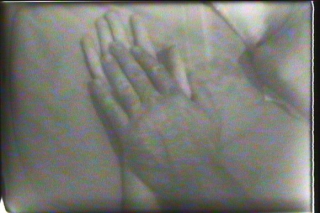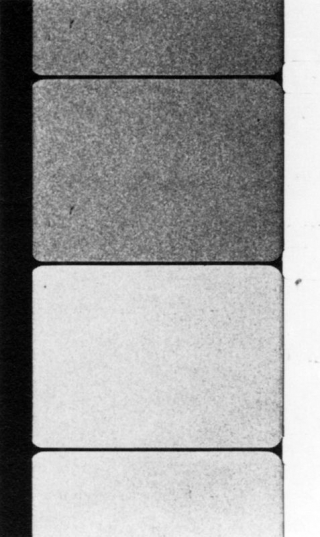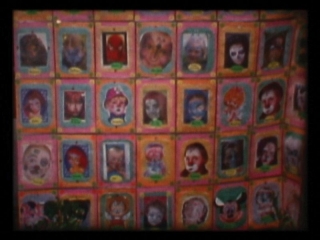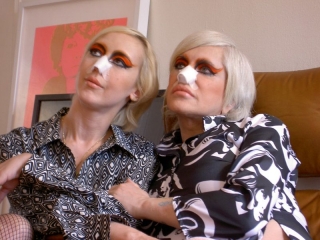Date: 30 October 2007 | Season: The Wire 25
THE WIRE 25: FILM
London Roxy Bar and Screen
30 October – 20 November 2007
THE WIRE 25: FILM presents three evenings of artists’ film and video at the Roxy Bar and Screen. The series begins with a programme of avant-garde classics, followed by UK premieres of four recent works by younger artists.
Curated by Mark Webber. Part of THE WIRE 25, a month long season of music celebrating The Wire magazine’s 25th birthday.
Tuesday 30 October 2007, at 8pm
CINEMA FOR THE EYES AND EARS
Tuesday 13 November 2007, at 8pm
THE ROAD TO WHO KNOWS WHERE
Tuesday 20 November 2007, at 8pm
EXTRAORDINARY LIVES
Back to top
Date: 30 October 2007 | Season: The Wire 25
CINEMA FOR THE EYES AND EARS
London Roxy Bar and Screen
Tuesday 30 October 2007, at 8pm
The potential for combining image and sound has been explored since the invention of cinema. This primer of classic works of the international avant-garde demonstrates some of the possibilities specific to the film medium, from the flickering frames of Tony Conrad, Paul Sharits and John Latham to the intricate optics of Daina Krumins, Malcolm Le Grice, and others. Featuring soundtracks by Brian Eno, Rhys Chatham, John Cale and Terry Riley. All films will be shown on 16mm.
Peter Kubelka, Arnulf Rainer, Austria, 1958, 8 min
Wojciech Bruszewski, YYAA, Poland, 1973, 5 min
John Latham, Speak, UK, 1968-69, 11 min
Malcolm Le Grice, Berlin Horse, UK, 1970, 8 min
Daina Krumins, The Divine Miracle, USA, 1973, 5 min
Paul Sharits, Axiomatic Granularity, USA, 1972-73, 20 min
Lis Rhodes, Dresden Dynamo, UK, 1974, 5 min
Tony & Beverly Conrad, Straight and Narow, USA, 1970, 11 min
The programme also screened at the ZXZW Festival on Tuesday 18 September 2007, at 9pm, at FilmFoyer, Tilburg, Netherlands.
PROGRAMME NOTES
CINEMA FOR THE EYES AND EARS
London Roxy Bar and Screen
Tuesday 30 October 2007, at 8pm
ARNULF RAINER
Peter Kubelka, Austria, 1958, 35mm, b/w, sound, 8 min
“He has even created a film whose images can no more be ‘turned off’ by the closing of eyes than can the soundtrack thereof it (for it is composed entirely of white frames rhythming thru black inter-spaces and of such an intensity as to create its pattern straight thru closed eyelids) so that the whole ‘mix’ of the audio-visual experience is clearly ‘in the head’, so to speak: and if one looks at it openly, one can see ones own eye cells as if projected onto the screen and can watch one’s optic physiology activated by the soundtrack in what is, surely, the most basic Dance of Life of all (for the sounds of the film do resemble and, thus, prompt the inner ear’s hearing of its own pulse output at intake of sound).” (Stan Brakhage)
YYAA
Wojciech Bruszewski, Poland, 1973, 35mm, colour, sound, 5 min
“The author of the film (appearing on the screen) is shouting “YAAAH…” The light comes from four sources being switched at random (this takes between 1 and 8 seconds) by an electronic device. In any moment, only one of the four lamps casts light on the filmmaker. Each light-change is accompanied by a different voice modulation of the author’s voice. The film technique makes it possible for the author to exhale for several minutes. The alternating close-ups and half-close-ups are totally unjustified.” (Wojciech Bruszewski)
SPEAK
John Latham, UK, 1968-69, 16mm, colour, sound, 11 min
“Speak is his second attack on the cinema. Not since Len Lye’s films in the thirties has England produced such a brilliant example of animated abstraction. Speak burns its way directly into the brain. It is one of the few films about which it can truly be said, ‘it will live in your mind’.” (Ray Durgnat)
BERLIN HORSE
Malcolm Le Grice, UK, 1970, 16mm, colour, sound, 8 min
“Berlin Horse is a synthesis of a number of works which explore the transformation of the image by re-filming from the screen and by complex printing techniques. There are two original sequences: a piece of early newsreel and a section of 8mm film shot in Berlin – a village in Northern Germany. The 8mm material is re-filmed in various ways from the screen onto 16mm and that in turn used for permutative superimposition and color treatment in the printer. The music is composed for the film by Brian Eno and like elements of the image, explores off-setting loops with each other so that their phases shift.” (Malcolm Le Grice)
THE DIVINE MIRACLE
Daina Krumins, USA, 1973, 16mm, colour, sound, 5 min
“An intriguing composite of what looks like animation and pageant-like live action is The Divine Miracle, which treads a delicate line between reverence and spoof as it briefly portrays the agony, death and ascension of Christ in the vividly coloured and heavily outlined style of Catholic devotional postcards, while tiny angels (consisting only of heads and wings) circle like slow mosquitoes about the central figure. Ms. Krumins tells me that no animation is involved, that the entire action was filmed in a studio, and that Christ, the angels and the background were combined in the printing. She also says it took her two years to produce it.” (Edgar Daniels)
AXIOMATIC GRANULARITY
Paul Sharits, USA, 1972-73, 16mm, colour, sound, 20 min
“In Spring 1972 a series of analyses of colour emulsion ‘grain’ imagery was undertaken (the word ‘imagery: is significant because only representations of light sensitive crystals, or ‘grain’, remain on a developed roll of colour film). The investigation is preliminary to the shooting of Section 1 of “Re: Re: Projection”, Variable Emulsion Density, wherein attempts to construct convincing lap dissolves of solid colour fields with straight fine grain Ektachrome ECO proved unsatisfactory. It was thought that more ‘grainy’ colour field interactions might adequately prevent the undesirable smoothness of hue mixture resulting from ECO superimposition. A discreteness of individual hues, during superimposition, is necessary; then, a switch to Ektachrome EF, pushed extra stops in development, seemed somewhat reasonable. Still, unexpected (colour blurring) problems arose and it was clear that a ‘blow up’ of the situation was called for; a set of primary principles was needed and, particle by particle, Axiomatic Granularity seemed to formulate itself. Its ‘structure’ lacks normative ‘expressive intentionality’.” (Paul Sharits)
DRESDEN DYNAMO
Lis Rhodes, UK, 1974, 16mm, colour, sound, 5 min
“The result of experiments with the application of Letraset and Letratone onto clear film. It is essentially about how graphic images create their own sound by extending into that area of film which is ‘read’ by optical sound equipment. The final print has been achieved through three separate, consecutive printings from the original material, on a contact printer. Colour was added with filters on the final run. The film is not a sequential piece. It does not develop crescendos. It creates the illusion of spatial depth from essentially flat, graphic, raw material.” (Tim Bruce)
STRAIGHT AND NARROW
Tony & Beverly Conrad, USA, 1970, 16mm, b/w, sound, 11 min
“An extension of the flicker film phenomenon, Straight and Narrow is a study in subjective colour and visual rhythm. Although it is printed on black and white film, the hypnotic pacing of the images will cause viewers to experience a programmed gamut of hallucinatory colour effects. Straight And Narrow uses the flicker phenomenon not as an end in itself, but as an effectuator of other related phenomena. In this film the colours which are so illusory in The Flicker are visible and under the programmed control of the filmmaker. Also, by using images which alternate in a vibrating flickering schedule, a new impression of motion and texture is created.” (Film-Makers’ Cooperative catalogue)
Back to top
Date: 13 November 2007 | Season: The Wire 25
THE ROAD TO WHO KNOWS WHERE
London Roxy Bar and Screen
Tuesday 13 November 2007, at 8pm
Two fragmented and dysfunctional road movies imagined as a series of episodic vignettes or misty memories. Jessie Stead’s Foggy Mountains Breakdown More Than Non-Foggy Mountains, a cryptic album of weird and wonderful versions of Flatt & Scrugg’s bluegrass standard won first prize at the Ann Arbor Film Festival. The Secret Apocalyptic Love Diaries of Enid Baxter Blader is a windswept folk-poem shot on a homemade video camera. Both cast a discreet nod of recognition to Harry Smith’s Anthology of American Folk Music.
Enid Baxter Blader, Secret Apocalyptic Love Diaries, USA, 2006-07, 12 min
Jesse Stead, Foggy Mountains Breakdown More Than Non-Foggy Mountains, USA, 2006, 59 min
PROGRAMME NOTES
THE ROAD TO WHO KNOWS WHERE
London Roxy Bar and Screen
Tuesday 13 November 2007, at 8pm
THE SECRET APOCALYPTIC LOVE DIARIES
Enid Baxter Blayder, USA, 2006-07, video, b/w, sound, 12 min
“Secret Apocalyptic Love Diaries consists of vignettes that document blinding lightning storms, violent rainfalls, and other radical, dramatic forces of nature, which are interspersed between narrative snippets that capture accidental, unscripted exchanges between friends and couples. From these vulnerable moments an intimate portrait emerges, one that depicts stumbling friendships and romantic relationships that start up and inevitably turn disappointing. The sense of vulnerability is enhanced by the video’s music, which was largely composed and performed by the artist, an accomplished singer, banjo player, and bluegrass musician originally from Appalachia. Sweet and tender, and awed by the ability of others to inspire and astonish, Secret Apocalyptic Love Diaries portends an inevitable, inexorable disappointment even in the most optimistic moments, such as the earliest days of a budding relationship. Its characters are vulnerable to forces of nature, both external or internal; to the affections and whims of others; to a driving rain that extinguishes one’s cigarette; to the unsettling presence of a lover’s former lover. From a howling dog accompanying a blues musician’s plaintive harmonica, to a group of bored friends standing around drinking while playing casually with power tools, to floodwaters pouring over a country road, the quiet melancholy in Secret Apocalyptic Love Diaries is as palpable as dark billows of smoke filling up a big clear sky.” (Irene Tsatsos)
FOGGY MOUNTAINS BREAKDOWN MORE THAN NON-FOGGY MOUNTAINS
Jessie Stead, USA, 2006, video, colour, sound, 59 min
“There are simultaneously many non-personal (structural, social and historical) reasons the bluegrass music instrumental Foggy Mountain Breakdown inspired the motion picture Foggy Mountains Breakdown More Than Non-Foggy Mountains. I cannot deny, however, that a highly distinctive resonance with this piece of music can be traced back to the newly formed eardrums of my own literal infancy. My biological father, having the daily habit of picking bluegrass banjo, accidentally subjected me to this instrumental (among others) as I did my time in the womb. The very fact of this inadvertent exposure, and what I can hazily identify as the primal origins of my personal sonic memory, lead me to confront Foggy Mountain Breakdown as the anachronistic soundtrack for the dawn of my awakening consciousness. In a macro sense, however, as representation of the bluegrass music genre (one identified as native to the USA, relatively speaking) Foggy Mountain Breakdown’s resonance as music will depend heavily on the social landscape it overlays. Its associations today are unquestionably nostalgic and instantly lend themselves to a stereotypically American ‘low-brow’ set of clichéd references; southern, rural, poor, white, etc. (especially within social constructions which identify with realities outside of these). In other words, the question of whether or not it is considered “enjoyable” may rely more on a degree of favour or distrust for the associations it recalls within the ear of the beholder(s), rather than on an evaluation of its formal characteristics. That said, how possible is the distillation of anything? How valuable is it? FMB MT N-FM’s premier flight of fancy is to pose these questions as animals bleached by the sun. These are questions of exposure and relativity … variety and socio-cultural identity … idealism and destination … the foggy mountain and the non-foggy mountain … and finally, the literal and the metaphysical question of where one maps oneself on the ‘world stage’.” (Jessie Stead)
Back to top
Date: 20 November 2007 | Season: The Wire 25
EXTRAORDINARY LIVES
London Roxy Bar and Screen
Tuesday 20 November 2007, at 8pm
Luke Fowler’s Bogman Palmjaguar is a portrait of its namesake, a former patient of radical psychologist R.D. Laing who now lives a hermetic life in the Flow Country of the Scottish Highlands. Documenting the environment of the surrounding landscape as much as its human focus, the images are accompanied by Lee Patterson’s evocative field recordings. Genesis P-Orridge and Lady Jaye are the subjects of Marie Losier’s diary/documentary, which pursues the pandrongynous partners at home, visiting MoMA’s Dada exhibition, and on tour with Thee Majesty and Throbbing Gristle.
Luke Fowler, Bogman Palmjaguar, UK, 2007, 30 min
Marie Losier, A Ballad with Genesis P-Orridge and Lady Jaye, France-USA, 2007, 37 min
PROGRAMME NOTES
EXTRAORDINARY LIVES
London Roxy Bar and Screen
Tuesday 20 November 2007, at 8pm
BOGMAN PALMJAGUAR
Luke Fowler, UK, 2007, video, colour, sound, 30 min
“Bogman Palmjaguar is a portrait of a man who after a series of disturbing events became distrustful of people and withdrew into nature. Bogman describes himself as ‘the hidden cat’ and ‘wild outlaw of paradise’ and is fighting against a diagnosis that that brands him as a ‘paranoid schizophrenic’. Bogman’s early life, and the diagnosis, subsequently conditioned his relationships with others, both within and beyond the medical establishment. The decision to take legal action to remove this label is of paramount importance to him, both as a search for justice and to seek reason in the course his life has taken over the past three decades. The film was shot across two visits to Bogman’s home in a remote village in the north of Scotland. The former was motivated by Bogman’s solicitor’s request of an independent report by Dr. Leon Redler (author and college of R. D. Laing), to assess whether the label ‘paranoid schizophrenic’ was justified. The latter was in collaboration with sound artist Lee Patterson, documenting the environment which Bogman sought to preserve during his time as a conservationist. Bogman had been passionate about the threatened habitat of Scotland’s Flow Country; a wilderness made of blanket bogs and peatlands that houses a unique diversity of wildlife. However the peatlands also became a hide-out, when Bogman fled attempts to section him. The film is a reconciliation of the young conservationist with his older self; isolated and withdrawn from society.” (Luke Fowler)
A BALLAD WITH GENESIS P-ORRIDGE AND LADY JAYE
Marie Losier, USA, 2007, video, colour, sound, 37 min
“I met Genesis by accidentally treading on her feet. I was at an opening in Soho, one of those where you can barely walk and breath and I ended up on her toes. I turned around to apologize and there she was, staring at me smiling with all her golden teeth glittering in my eyes. That’s where it all started. For a while we emailed, learning about each other more and more and one day I ended up in her house, sitting on a giant plastic green chair in the shape of a hand. Since that day I’ve been, in a way, adopted by the family of mom and pop, as Genesis and Lady Jaye call themselves, and by the whole Psychic TV3 band. I’ve been filming them at their home, waking up and going through the routine of being Pandrogynes, which is their main art work today: it’s a living performance in a way. They’ve been having plastic surgery to resemble one another, or rather to be closer to each other in order to break the binary system of male/female, good/bad … creating a third identity that is free from the rules of society. It’s been now a year since I started shooting: they took me on tour in Europe with them, to film them on the routine of the tour. My camera and myself have been totally invited to their life at the rehearsals with the whole band, at home with their favourite person, their dog, Big Boy, with friends, their daughters, going through their incredibly busy daily lifestyles between recording albums, preparing concerts, being in three bands, making art pieces for gallery shows, writing books, doing a raw food diet, shopping for mini skirts, cleaning, and growing their garden in their Bushwick house … there is a lot more I need to capture, but what you will see now is a sort of love ballad for them.” (Marie Losier)
Back to top



